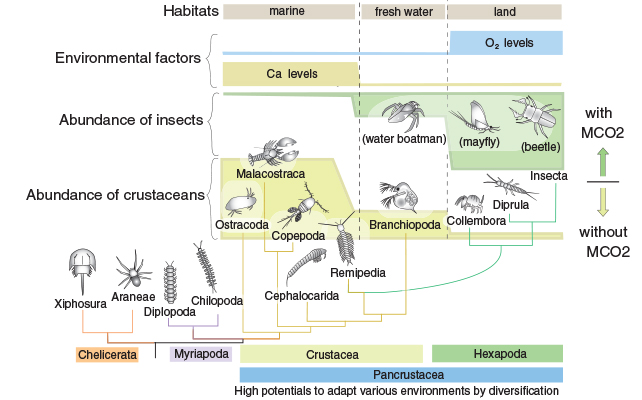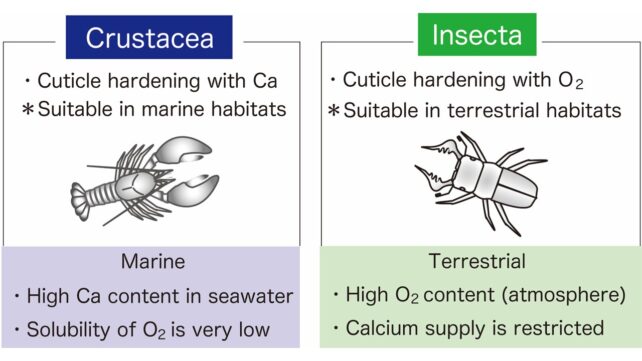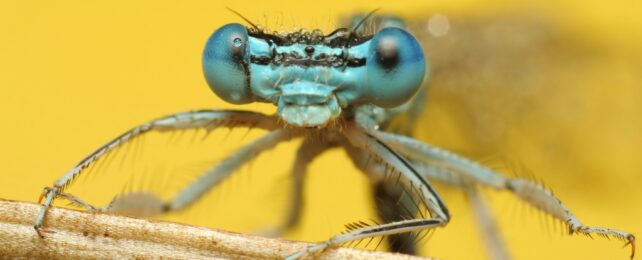Insects have been around for close to 480 million years, giving them plenty of time to creep, crawl, burrow and flutter all over our planet's surface.
Well, just about all over. Surprisingly few species live in the oceans, and scientists have been trying to figure out why that's the case.
A research team from the US and Japan recently came up with an interesting hypothesis for this, claiming to have discovered a "simple explanation to a long-standing question".
They propose that a unique enzyme that helps insects harden their casings, called multicopper oxidase-2 (MCO2), is the reason why they are rare in marine environments but do well on land.
Biologist Tsunaki Asano from Tokyo Metropolitan University, who led the team, has previously shown that insects have evolved a special mechanism to harden their tough, outer layer that uses molecular oxygen and MCO2.
Now Asano and colleagues explain in a published review how this puts the various critters at a disadvantage in the oceans but helps them to thrive out of it. It essentially comes down to the abundance of chemicals in each environment, and how lightweight insect exoskeletons are.
"The emergence of insects is an important event in the evolution of life on Earth," the team writes, "and highlights a key adaptive expansion of living organisms into a new, terrestrial ecosystem."
Some of the planet's most successful creatures, insects are the largest group in the phylum Arthropoda, which contributes the largest biomass of all terrestrial animals. They play a crucial role in maintaining the balance of life on Earth.
Recent insights from molecular phylogenetics have revealed that insects and crustaceans (which mostly live in oceans) belong to the same clade, called Pancrustacea.

Though insects diverged from their crustacean ancestors and developed land-based lifestyles, both still have exoskeletons made of wax and a tough cuticle of carbohydrates called chitin.
This cuticle is a protective layer that lines the body's surface, keeping moisture in and germs out, not unlike our skin. More than just a pretty casing, it also protects the body from external mechanical forces and helps maintain the body's shape and mobility, acting as an external scaffold.
However, while crustaceans primarily use calcium from seawater to harden their cuticles into shells, insects use molecular oxygen to transform their cuticles into durable casings for their organs through the mediation of MCO2.

Asano and coworkers argue the presence of oxygen in the air makes land a lot more inviting to insects. The sea is now a harsh place for them because there isn't enough oxygen, not to mention it already houses and feeds many better-adapted species.
To insects' advantage, their cuticle gets harder and drier through the MCO2 pathway, which creates a biomaterial that is protective while more or less staying as light as a feather. This is a striking distinction compared to crustaceans, whose shells are much denser due to a direct proportion between shell density and calcification level, which doesn't lend itself well to a life in the air.
Insects may have developed the ability to climb plants, glide, and eventually fly thanks to MCO2's action, allowing them to move around more easily and fill in previously unoccupied ecological niches.
The team thinks that MCO2 might be what makes insects unique; as they say in their paper, "no MCO2, no insects."
Further explaining the insect specificity, Asano and team points out that: "other arthropods including the closest relatives of insects, the non-insect hexapods like springtails and two-pronged bristletails, do not possess genes for MCO2."
The researchers note that insects aren't the only arthropods that have adapted to life on terra firma, so MCO2 isn't a necessary requirement for successfully moving out of your ocean abode and setting up house on dry land.
But the unique way that insects' cuticles are made does provide a lot of information about how well they evolved to reside in the land environment.
"If insects had not acquired the MCO2-mediated system, insect evolution and success might have been significantly different from what we currently observe," the team concludes.
"We hope for further discussions on insect evolution and terrestrialization based on this viewpoint."
The review has been published in Physiological Entomology.
